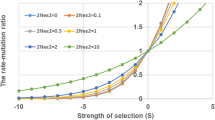Abstract
A pair of mutations at different loci (or sites) which are singly deleterious but restore normal fitness in combination may be called compensatory neutral mutations. Population dynamics concerning evolutionary substitutions of such mutants was developed by making use of the diffusion equation method. Based on this theory and, also, by the help of Monte Carlo simulation experiments, a remarkable phenomenon was disclosed that the double mutants can easily become fixed in the population by random drift under continued mutation pressure if the loci arc tightly linked, even when the single mutants are definitely deleterious. More specifically, I consider two loci with allelesA andA’ in the first locus, and allelesB andB’in the second locus, and assign relative fitnesses 1, 1-s’, 1-s’ and 1 respectively to the four gene combinationsAB, A’B, AB’ andA’B’, wheres’ is the selection coefficient against the single mutants (s’ > 0). Letv be the mutation rate per locus per generation and assume that mutation occurs irreversibly fromA toA’ at the first locus, and fromB toB’ at the second locus, whereA andB are wild type genes, andA’ andB’ are their mutant alleles. In a diploid population of effective size N e (or a haploid population of 2N e breeding individuals), it was shown that the average time (T) until joint fixation of the double mutant (A’B’) starting from the state in which the population consists exclusively of the wild type genes (AB) is not excessively long even for large 4N e s’ values. In fact, assuming2N e v = 1 we have -T = 54Ne for 4Nes’ = 400, and -T = 128Ne for 4N e s’ = 1000. These values are not unrealistically long as compared with -T~ 5N e obtained for 4N e s’ = 0. The approximate analytical treatment has also been extended to estimate the effect of low rate crossing over in retarding fixation. The bearing of these findings on molecular evolution is discussed with special reference to coupled substitutions at interacting amino acid (or nucleotide) sites within a folded protein (orrna) molecule. It is concluded that compensatory neutral mutants may play an important role in molecular evolution.
Similar content being viewed by others
References
Crow J F and Kimura M 1970An introduction to population genetics theory (New York: Harper and Row)
Haldane J B S 1931Proc. Cambridge Philos. Soc. 27: 137–142
Kimura M 1964J. Appl. Probab. 1: 177–232
Kimura M 1968Nature (London) 217: 624–626
Kimura M 1980Proc. Natl. Acad. Sci. USA 77: 522–526
Kimura M 1983The neutral theory of molecular evolution (Cambridge: University Press)
Kimura M and King J L 1979Proc. Natl. Acad. Sci. USA 76: 2858–2861
Kimura M and Ohta T 1971Theoretical aspects of population genetics (Princeton: University Press)
Kimura M and Ohta T 1974Proc. Natl. Acad. Sci. USA 71: 2848–2852
Li W-H and Nei M 1977Genetics 86: 901–914
Ohta T 1973Nature (London) 246: 96–98
Ohta T 1974Nature (London) 252: 351–354
Ozeki H, Inokuchi H, Yamao F, Kodaira M, Sakano H, Ikemura T and Shimura Y 1980 inTransfer RNA: biological aspects (eds.) D Soil, J Abelson and P Schimmel (Cold Spring Harbor Laboratory) pp. 341–362
Tsukihara T, Kobayashi M, Nakamura M, Katsube Y, Fukuyama K, Hase T, Wada K and Matsubara H 1982Biosystems 15: 243–257
Wright S 1932Proc. VI Int. Congr. Genet. 1: 356–366
Wright S 1977Experimental results and evolutionary deductions. Evolution and the genetics oj populations (Chicago and London: University of Chicago Press) Vol. 3, Chap. 13
Wyckoff H W 1968Brookhaven Symp. Biol. 21: 252–257
Yanofsky C, Horn V and Thorpe D 1964Science 146: 1593–1594
Author information
Authors and Affiliations
Additional information
Contribution No. 1610 from the National Institute of Genetics, Mishima, Shizuoka-ken, 411 Japan.
Rights and permissions
About this article
Cite this article
Kimura, M. The role of compensatory neutral mutations in molecular evolution. J. Genet. 64, 7–19 (1985). https://doi.org/10.1007/BF02923549
Received:
Issue Date:
DOI: https://doi.org/10.1007/BF02923549




